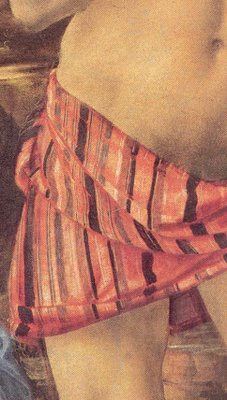A Divine Bush
 Exodus tells the story of how Moses encountered a burning bush while tending his father-in-law’s flock on Mount Horeb. I’ve only seen a burning bush once in my life. It belonged to a redhead. I had never seen red pubes before, and I found them quite fetching, even though he was kind of a dolt.
Exodus tells the story of how Moses encountered a burning bush while tending his father-in-law’s flock on Mount Horeb. I’ve only seen a burning bush once in my life. It belonged to a redhead. I had never seen red pubes before, and I found them quite fetching, even though he was kind of a dolt.Anyway, Exodus also tells how God called out to Moses from in the midst of the bush. I guess you could say it was a divine bush. I suppose Jesus’ bush would also be considered divine by contemporary evangelicals, seeing that they believe he’s the Son of God and all that. All I know is that when I recently came across a Renaissance painting showing Jesus’ pubes, I thought to myself, “Now that’s a divine bush.”
It all started this past weekend while I was visiting my sister and brother-in-law and their kids for my nephew’s second birthday. My sister, who’s probably the sweetest and most generous person I know, though a bit of a compulsive gift giver, gave me a coffee-table book of Leonardo da Vinci’s works.
 Actually, it was Will over at DesignerBlog, in response to my post about David’s pubes, who commented that da Vinci, like Michelangelo, did not shy away from including pubes in his male nudes
Actually, it was Will over at DesignerBlog, in response to my post about David’s pubes, who commented that da Vinci, like Michelangelo, did not shy away from including pubes in his male nudes  and he cited the Vitruvian Man (1492, pen and ink, Gallerie dell’Accademia, Venice) as one example. Some of da Vinci’s other anatomical sketches also show pubic hair. Still, I was not prepared for what awaited me as I flipped through the book my sister gave me.
and he cited the Vitruvian Man (1492, pen and ink, Gallerie dell’Accademia, Venice) as one example. Some of da Vinci’s other anatomical sketches also show pubic hair. Still, I was not prepared for what awaited me as I flipped through the book my sister gave me.The book contained a detail of Christ’s midsection from The Baptism of Christ (1472-1475, oil on wood, Galleria degli Uffizi, Florence) by Andrea del Verrocchio (1435-1488). As an adolescent, da Vinci had worked in Verrocchio’s studio, and most art historians agree that da Vinci made significant contributions to Verrocchio’s Baptism. However, whether or not he is responsible for painting Jesus’ pubes, I don’t know.
 What I do know is that this pubic hair is imbued with theological significance. By lending the painting a note of realism, the pubes were probably intended to highlight the doctrine of the incarnation (the Word made Flesh) and emphasize Christ’s humanity. The pubes were meant to remind viewers that Jesus was a real man with a real body and real pubic hair.
What I do know is that this pubic hair is imbued with theological significance. By lending the painting a note of realism, the pubes were probably intended to highlight the doctrine of the incarnation (the Word made Flesh) and emphasize Christ’s humanity. The pubes were meant to remind viewers that Jesus was a real man with a real body and real pubic hair.And I could be mistaken, but it looks to me like Jesus did a little bit of manscaping.












3 Comments:
I nearly peed myself. Good thing I was reading this in the tub.
I love your style.
Thanks, guys :)
Oh, and btw, I pee in the tub all the time. In the shower too.
Read Leo Steinberg's THE SEXUALITY OF CHRIST IN RENAISSANCE PAINTING AND MODERN OBLIVION.
Post a Comment
<< Home